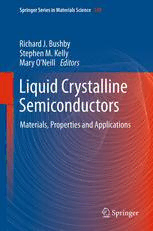
Liquid Crystalline Semiconductors: Materials, properties and applications PDF
Preview Liquid Crystalline Semiconductors: Materials, properties and applications
Springer Series in Materials Science Volume 169 SeriesEditors ZhimingM.Wang,Fayetteville,AR,USA ChennupatiJagadish,Canberra,ACT,Australia RobertHull,Charlottesville,VA,USA RichardM.Osgood,NewYork,NY,USA Ju¨rgenParisi,Oldenburg,Germany Forfurthervolumes: http://www.springer.com/series/856 TheSpringerSeriesinMaterialsSciencecoversthecompletespectrumofmaterials physics,includingfundamentalprinciples,physicalproperties,materialstheoryand design.Recognizingtheincreasingimportanceofmaterialsscienceinfuturedevice technologies,thebooktitlesinthisseriesreflectthestate-of-the-artinunderstanding andcontrollingthestructureandpropertiesofallimportantclassesofmaterials. Richard J. Bushby (cid:129) Stephen M. Kelly Mary O’Neill Editors Liquid Crystalline Semiconductors Materials, Properties and Applications 123 Editors RichardJ.Bushby StephenM.Kelly SchoolofChemistry DepartmentofChemistry UniversityofLeeds UniversityofHull Leeds Hull UK UK MaryO’Neill DepartmentsofPhysicsandMathematics UniversityofHull Hull UK PublishedbySpringer, P.O.Box17,3300AADordrecht,TheNetherlands ISSN0933-033X ISBN978-90-481-2872-3 ISBN978-90-481-2873-0(eBook) DOI10.1007/978-90-481-2873-0 SpringerDordrechtHeidelbergNewYorkLondon LibraryofCongressControlNumber:2012954012 ©SpringerScience+BusinessMediaDordrecht2013 Thisworkissubjecttocopyright.AllrightsarereservedbythePublisher,whetherthewholeorpartof thematerialisconcerned,specificallytherightsoftranslation,reprinting,reuseofillustrations,recitation, broadcasting,reproductiononmicrofilmsorinanyotherphysicalway,andtransmissionorinformation storageandretrieval,electronicadaptation,computersoftware,orbysimilarordissimilarmethodology nowknownorhereafterdeveloped.Exemptedfromthislegalreservationarebriefexcerptsinconnection with reviews or scholarly analysis or material supplied specifically for the purpose of being entered and executed on a computer system, for exclusive use by the purchaser of the work. Duplication of this publication or parts thereof is permitted only under the provisions of the Copyright Law of the Publisher’slocation,initscurrentversion,andpermissionforusemustalwaysbeobtainedfromSpringer. PermissionsforusemaybeobtainedthroughRightsLinkattheCopyrightClearanceCenter.Violations areliabletoprosecutionundertherespectiveCopyrightLaw. Theuseofgeneraldescriptivenames,registerednames,trademarks,servicemarks,etc.inthispublication doesnotimply,evenintheabsenceofaspecificstatement,thatsuchnamesareexemptfromtherelevant protectivelawsandregulationsandthereforefreeforgeneraluse. While the advice and information in this book are believed to be true and accurate at the date of publication,neithertheauthorsnortheeditorsnorthepublishercanacceptanylegalresponsibilityfor anyerrorsoromissionsthatmaybemade.Thepublishermakesnowarranty,expressorimplied,with respecttothematerialcontainedherein. Printedonacid-freepaper SpringerispartofSpringerScience+BusinessMedia(www.springer.com) Preface This is an exciting stage in the development of organic electronics. No longer is itanareaofpurely‘academicinterest’butincreasinglyrealapplicationsarebeing developed and some of these are beginning to come on-stream. There have been severaldriversforthe surgeofinterestshownby the electronicsindustry.Perhaps the greatest is the promise afforded by organic systems for low-cost processing, e.g.,methodsoffabricationsuchasroll-to-rollcontactprintingorink-jetprintingin whichthecomponentsare‘assembled’onlow-costsubstratesatroomtemperature. Thelong-termvisionisforthecreationofintegrateddevicesinwhich,forexample, aphotovoltaiccell,asensorandadisplay,allmadeoforganicmaterials,isprinted ontoaplasticfilminasingleoperation.Anotherfactorintherecentdevelopmentof organicelectronicsisthehugeadvancesmadeinorganicsynthesisoverthelasthalf century,which make it easy to fine-tune the properties of organicsat a molecular level in a way that is simply not possible for their metallic and semi-metallic counterparts.Finally,organicsaremucheasiertointerfacewithbiomaterials,which is perhaps the key problem in the development of new generation biosensors. Another consideration in the developmentof organic electronics has been ‘Green Issues’:notonlythe needto developenergy-efficientmethodsof manufacturebut also the need to develop methods based on renewable (organic) rather than finite (inorganicandmetallic)components. Althoughitseemsimprobablethatorganicswillevercompetewithsilicon-based devicesintermsofhigh-endcomputingapplications,wheredevicespeedisofthe essence, there are many low-end areas of application, where we can look to see traditionalinorganiccomponentsincreasinglyreplacedbyorganics.Areasthathave already been commercially developed or which are under intensive development includeorganiclightemittingdiodes(forflatpaneldisplaysandsolidstatelighting), organicphotovoltaiccells,organicthinfilmtransistors(forsmarttagsandflatpanel displays)andsensors.Potentiallythisisa fieldthatwillaffecteveryaspectofour livesandhaveanimpactineveryhomeandineverybusiness. Within the family of organic electronic materials, liquid crystals are relative newcomers. The first electronically conducting liquid crystals were only reported in1988,butalreadyasubstantialliteraturehasdeveloped.Thepotentialadvantage v vi Preface of liquid crystalline semiconductors is that they have the easy processabilty of amorphous and polymeric semiconductors, but they usually have higher charge carrier mobilities. Their mobilities do not reach the levels seen in crystalline organics,buttheycircumventallofthedifficultissuesofcontrollingcrystalgrowth and morphology. Liquid crystals self-organise, they can be aligned by fields and surfaceforcesand,becauseoftheirfluidnature,defectsinliquidcrystalstructures readilyself-heal. Because this is a relatively young field, there are still issues which need to be understood. In particular, the theory of electronic conduction in liquid crystals is muchlesswelldevelopedthanthatofelectronicconductioninotherorganicmate- rialsand,althoughtherelationshipbetweenmolecularstructureandconductivityis mostlyunderstood,someissuesstillremaintoberesolvedandunderstood. With these matters in mind, this is an opportune moment to bring together a monograph on the subject of ‘Liquid Crystalline Semiconductors’. The field is already too large to cover in a comprehensive manner, so our aim has been to bring together contributionsfrom leading workers, which cover the main areas of thechemistry(synthesisandstructure/functionrelationships),physicsandpotential applications. A general introductionto liquid crystals and the nature and kindsof their mesomorphic behaviour and structure (mesophases) is given in Chap. 1. A description of the nature and mechanisms of different kinds of charge transport in calamitic (nematic and smectic) liquid crystalline semiconductors is given in Chap. 2 followed by a similar treatment of columnar (discotic) liquid crystalline semiconductorsin Chap. 3. The differentapproachesand methodsof determining charge transport in liquid crystals are also described in detail. Chap. 4 provides a comprehensive description of the synthesis of a wide range of columnar liquid crystalline semiconductors. A series of reaction schemes are used to illustrate differentsyntheticstrategiesandapproachestothesynthesisofthisspecialtypeof liquidcrystal.Chapter5givesanextensivediscussionofthenatureandmagnitude ofchargetransportinreactivemesogens(monomers)andhowtheyaredetermined. A similar treatment of the corresponding liquid crystal polymer networks is also given in this chapter. An insight into the nature and complexity of the optical properties of liquid crystals is provided in Chap. 6. Chapters 7, 8 and 9 describe the modes of operation, configurationand performance of a range of electrooptic devices, i.e., organic light-emitting diodes (OLEDs), especially with polarised emission, organic photovoltaics and organic field-effect transistors, incorporating thetypesofliquidcrystallinesemiconductorsdescribedin theprecedingchapters. Our hope is that this book will provide a useful introduction to the field both for thoseinindustryandforthoseinacademiaandthatitwillhelptostimulatefuture developments. RichardJ.Bushby StephenM.Kelly MaryO’Neill Contents 1 IntroductiontoLiquidCrystallinePhases................................ 1 JohnE.Lydon 2 ChargeCarrierTransportinLiquidCrystallineSemiconductors..... 39 Jun-IchiHanna 3 ColumnarLiquidCrystallineSemiconductors........................... 65 RichardJ.BushbyandDanielJ.Tate 4 SynthesisofColumnarLiquidCrystals................................... 97 SandeepKumar 5 Charge Transport in Reactive Mesogens and Liquid CrystalPolymerNetworks.................................................. 145 T.KreouzisandK.S.Whitehead 6 OpticalPropertiesofLight-EmittingLiquidCrystals................... 173 MaryO’NeillandStephenM.Kelly 7 OrganicLight-EmittingDiodes(OLEDs)withPolarisedEmission.... 197 E.SchelerandP.Strohriegl 8 LiquidCrystalsforOrganicPhotovoltaics................................ 219 MaryO’NeillandStephenM.Kelly 9 LiquidCrystalsforOrganicField-EffectTransistors.................... 247 MaryO’NeillandStephenM.Kelly Index............................................................................... 269 vii Contributors RichardJ.Bushby SchoolofChemistry,UniversityofLeeds,Leeds,UK Jun-IchiHanna ImagingScienceandEngineeringLaboratory,TokyoInstituteof Technology,Yokahama,Japan StephenM.Kelly DepartmentofChemistry,UniversityofHull,Hull,UK T.Kreouzis DepartmentofPhysics,QueensMary,UniversityofLondon,London, UK Sandeep Kumar Soft Condensed Matter Group, Raman Research Institute, Bangalore,India JohnE.Lydon FacultyofBiologicalSciences,UniversityofLeeds,Leeds,UK MaryO’Neill DepartmentofPhysicsandMathematics,UniversityofHull,Hull, UK E. Scheler Lehrstuhl fuer Makromolekular Chemie I, Bayreuther Institut fuer MakromolekulforschungBIMF,UniversityofBayreuth,Bayreuth,Germany P. Strohriegl Lehrstuhl fuer Makromolekular Chemie I, Bayreuther Institut fuer MakromolekulforschungBIMF,UniversityofBayreuth,Bayreuth,Germany DanielJ.Tate OrganicMaterialsInnovationCentre,SchoolofChemistry,Univer- sityofManchester,Manchester,UK K. S. Whitehead Department of Physics, Queens Mary, University of London, London,UK ix
